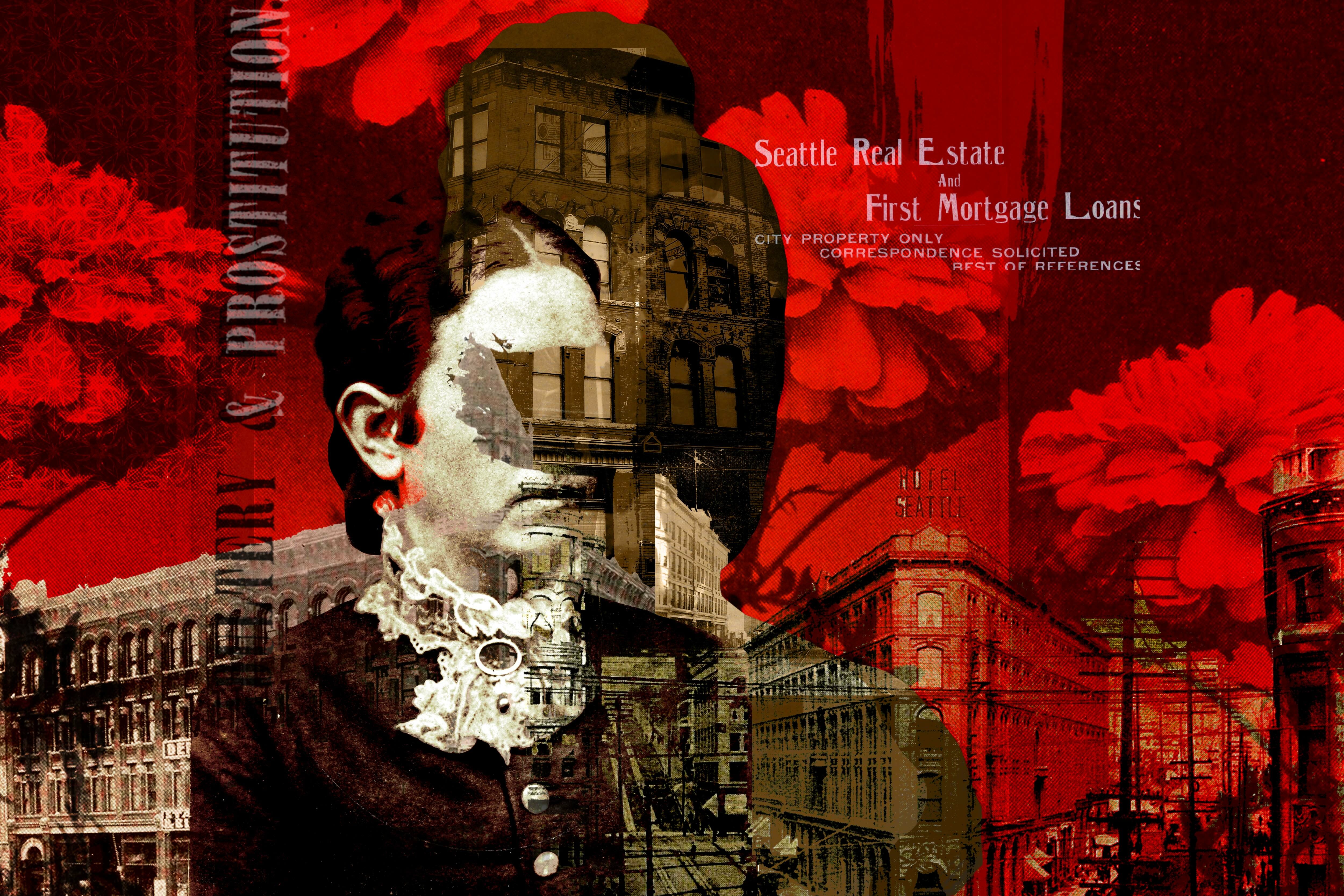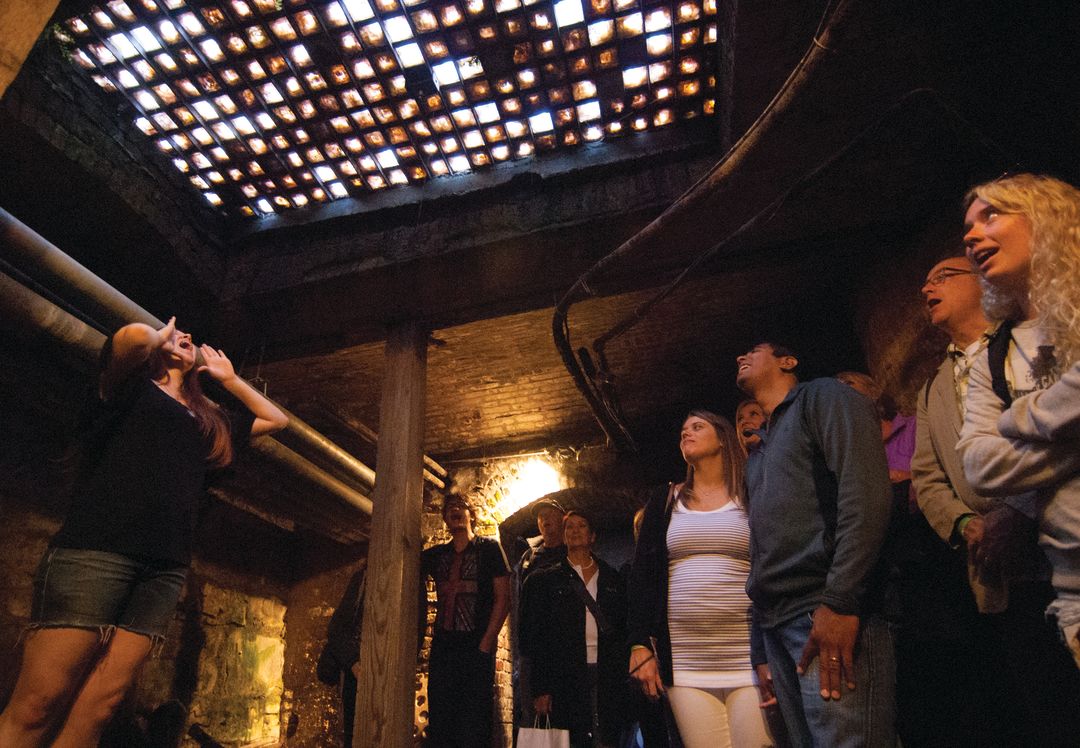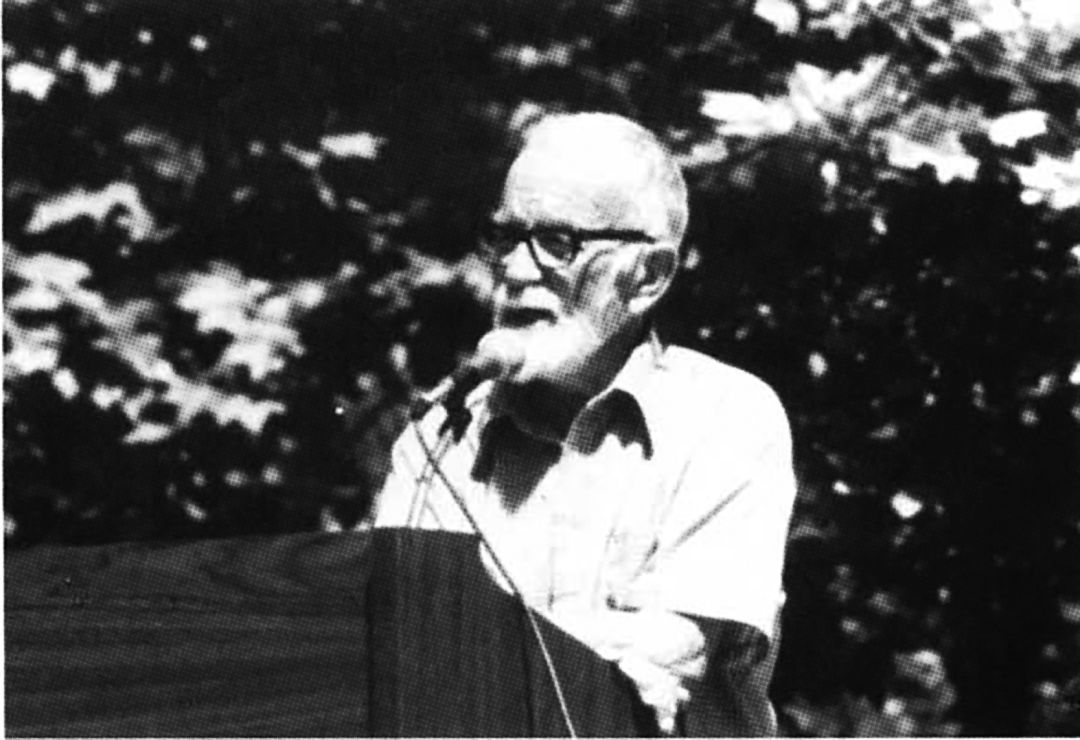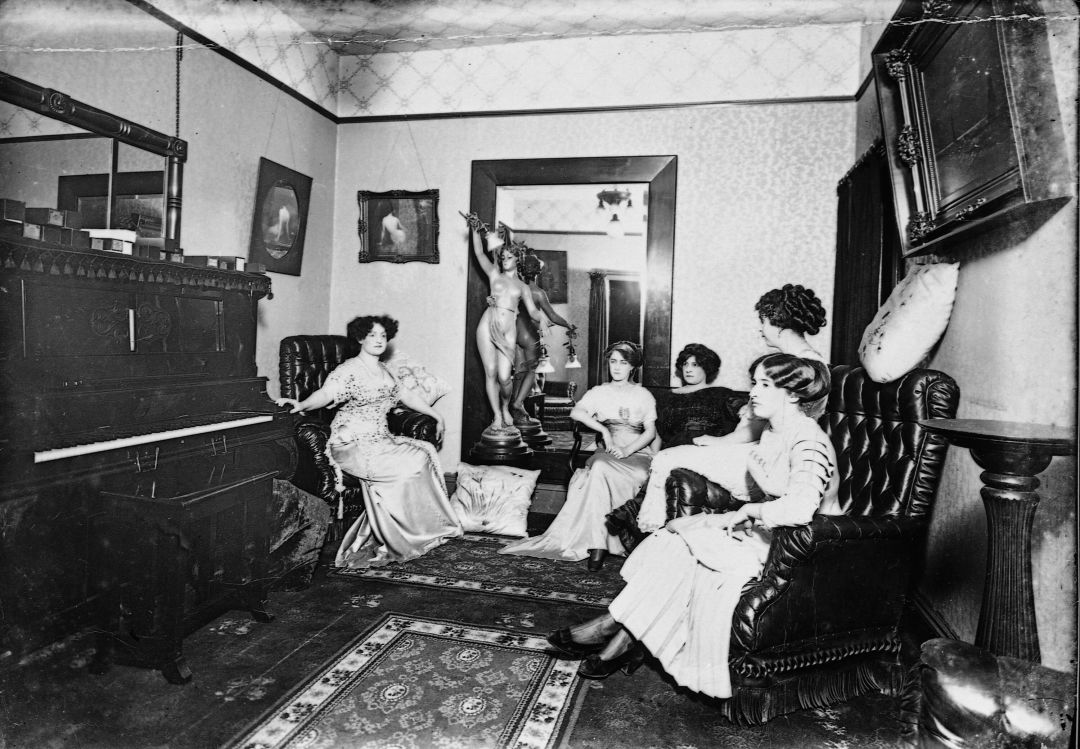
Lou Graham, Seattle's Misunderstood Madam
Illustration by Eleanor Shakespeare.
In the gift shop of Bill Speidel’s Underground Tour, an enormous black-and-white photograph looms over the T-shirts and history books for sale. A stern-looking woman with dark, frizzy hair commands the group in the picture. She sits, ramrod straight and draped in silk, wearing rouge seemingly applied by a small spatula. A sign beneath the picture tells visitors this is Lou Graham, the brothel boss who built Seattle. The women around her look out from under their glossy, finger-waved coifs with dour mouths and heavily painted eyes.
I’ve just completed my second visit to this oddball attraction, a guided walk through the labyrinth of basements, below-ground walkways, and back entrances beneath the colorful pavement glass of Pioneer Square. Since the 1960s, countless tourists, locals, and field trip groups have strolled these tunnels, a subterranean souvenir of Seattle’s efforts to regrade its streets to a higher elevation after the Great Seattle Fire in 1889.
Docents do their own research and punch up the results with a liberal dose of punny jokes, so the tour differs depending on when you go. Seattle’s early sewer woes, toilets that flush in reverse at high tide, always draw laughs. But at some point, conversation inevitably turns to Graham. Seattle’s legendary madam could buy off anyone to keep her bordello operational and staffed, our tour guide informs us. Stories of her largesse include bailing out the city after the Great Seattle Fire and donating land to the King County public school system.
And the women who worked for Graham—the ones who ostensibly surround her in that photo? On the tour, we learn they used euphemistic job titles, like “seamstress.” As a result, Seattle’s census overflowed with seamstresses—who could barely sew a stitch. This punch line predictably elicits titters from the group.
Since my trip to the underground, I’ve spent a lot of time with Graham’s ghost. I mapped her family tree back in Germany until, one branch at a time, it was terminated by war and illness. I sat in archives wearing a borrowed pair of white cotton gloves, touching her receipts and bills. I read the long list of her personal effects and valuables, tallied up by lawyers after her death. I saw her final doctor’s bill and the slip from the Bonney Watson funeral home, signed by L.W. Bonney, detailing the black horses that pulled her casket on a carriage as part of her funeral procession.

Bill Speidel’s Underground Tour offers a cheeky perspective on Pioneer Square.
What I found was a hard-working immigrant, a savvy and generous boss, and a woman with more property deeds to her name than most of the men working in the Dexter Horton building.
What I didn’t find was much of the narrative I heard on the Underground Tour—the same one enshrined in any article or book that mentions Graham, or on the historical plaque in Seattle’s downtown. Because almost every single piece of modern writing on Graham, from Wikipedia to Washington’s respected HistoryLink to articles published by this magazine, cite one man—and no one else.
When Bill Speidel looked out the window of his fourth-floor office in the recently renovated Pioneer Building, he had a view of Seattle’s history—and of its potential future. Even after he became a PR flack, the man friends called “Spy” carried himself like an old-time journalist, down to the bow tie and black-rimmed glasses. His gravelly voice betrayed his voracious appetite for cigarettes and, until he got sober, strong drink. He was a true son of Seattle; his father, William Speidel Sr., had been a football captain at the University of Washington, about the most local cred a man could have.

Bill Speidel giving an address in June 1979.
By the 1960s, the city was at a crossroads. Seattle hosted the World’s Fair in 1962, adding the Space Needle to its skyline and proclaiming its role in America’s space-age future. Boeing’s presence earned it the nickname Jet City. Now, the town was embroiled in big questions about what it meant to grow into this moniker.
Plans were afoot to replace the iconic buildings of Seattle’s oldest neighborhood with the kind of brutalist cement eyesores taking over the city—like the monstrosity of a parking garage planned for the site of the old Seattle Hotel, across from Speidel’s office. Classic brick buildings made way for modern apartment houses and hulking halls of bureaucracy. Old, run-down Pioneer Square was the last place the city’s touristy organizations wanted to send people.
To combat the steamrolling, Speidel adopted the role of historian. By revealing the secret tunnels of Pioneer Square, he hoped, more would believe the buildings above were worth saving. “We were pitching restoration, not devastation,” Speidel told Jean Godden, a former city councilmember, later a columnist for the Seattle Post-Intelligencer.
In a 1964 Seattle Daily Times column, Speidel exposed newspaper readers to the musty, nearly untouched historical relics under Seattle’s present-day sidewalks. The public flooded his office with letters asking how they could see the underground and learn more about this history. Speidel began giving formal tours—often including stops for a pint in some of his favorite spots—for a $1 suggested donation. He recruited high school students to help clean the place up so the passageways came off captivating rather than creepy.
His plan worked. Not only did tens of thousands of people flock to the tours, but they became evangelists for Pioneer Square. They left imbued with a sense of urgency to save these old spaces.
Capitalizing on this interest, Speidel wrote and published numerous historical and historically adjacent books, including Sons of the Profits. His writing echoed his speech pattern—punctuated with quips, verging on run-on sentences. His stories were gleaned from old-timers who wanted to chat, not in-depth examinations of property records. There are puns and ellipses, but hardly any sourcing to be found. These were exuberant tales, not stuffy historical volumes.
In many ways, his inclusion of Graham and her “ladies from Hades” preserved them as important members of the city’s past. But the work seemed to stop when Speidel did—he died in 1988. As a result, his version, accurate or not, is the only one left.
Her story’s there if you look for it. By August 4, 1891, Lou Graham was a common sight on Seattle’s streets. She cut a memorable figure in stylish, imported attire—a pinched shirtwaist, voluminous sleeves, and a small hat perched on her large, piled hair—standing out in a city still on the edge of wilderness. On this warm day, Graham left her temporary residence on Jackson Street, navigating the mud, refuse, and animal excrement of Pioneer Square. She likely stopped by Third and Washington to check on construction of her new three-story brick building rising from the ashes of Seattle’s devastating fire. Here, Graham would continue to build a reputation as “a very well-known woman to the Seattle under-world,” as The Seattle Star newspaper described her.

The photo often used to depict Lou Graham has no confirmed connection with the famous madam.
Image: Courtesy Paul Dorpat
Graham was the closest thing this frontier town had to a reality TV star. Local papers spared no detail in chronicling her fashions and baubles. She wore diamonds at her neck, wrists, bust, and throat, not to mention the diamond-encrusted “miniature dagger” hat pin estimated to be worth about $8,500 today. They were a significant weight to carry in the heat as Graham headed up the steep slope of First Hill, in impractical heeled boots, toward the new King County courthouse. Before Interstate 5 bisected the city, locals dubbed this climb “Profanity Hill” for the lawmakers, attorneys, and permit-seekers who huffed and cursed their way upward.
Once at the courthouse, she filed a series of documents to become a naturalized U.S. citizen, signing her name in a loopy scroll. It was mostly a formality. She was already established in Seattle, a successful businesswoman, a property owner, and in the process of amassing more wealth than any other single woman would know here for decades to come. But technically, she should have done this long ago, certainly before she purchased any land.
Graham never completed the process she began that day. We don’t know why. After her death, that curious oversight would leave her ample assets in limbo for close to a decade.
Civic records, property details, and legal notes help build a picture of Graham. But, despite that enormous photo in the Underground Tour gift shop, modern-day Seattle somehow still has no official record of what she looked like. There are few, if any, verified descriptions of Graham. The many newspaper accounts never describe her looks, most likely indicating that they were not, by the standards of the time, remarkable.
The shape of her face and the color of her eyes have been otherwise lost to history, but some details of her life do remain. Graham came to the United States from Germany as a teenager named Elise Oben. She was functionally alone beginning at the age of 16. From New York, she disappears, only to resurface in her late 20s as a new property owner in Pioneer Square. It’s unclear how she got there, or even when.
Just like luxury housing developers came out for Amazon workers in 2015, Graham showed up for a boomtown in need. Seattle’s exploding population overflowed with virile men who had come looking for work in the woods or on the waterfront or out on one of the boats bound for Alaskan gold fields. She established a business that was a sure thing. How she learned the tricks of the trade, we don’t know.
Within a few years, The Seattle Daily Times described her as “a woman well-known in the tenderloin district.” The 1900 article detailed how she paid the legal fees of a woman who killed her abusive boyfriend in self-defense. Graham reportedly didn’t know the woman but read about her case in the paper and lent her $1,000—close to $35,000 today. Before long she was a frequent character in the newspaper.
Women working in her brothel could expect higher-than-average wages—by a factor of 10, at least—than personal maids or those squinting over stitches in a garment factory. Over the years, Graham took in and cared for multiple children whose parents abused alcohol or had gone bust in the Klondike. She employed individuals of all races, including Indigenous women (which was illegal at the time) and numerous Chinese immigrants in an era when anti-Asian sentiment fomented full-on riots. Her estate filings refer to her longtime right-hand man simply as “Chong,” but Graham trusted him with her business dealings.
One of the few records which contains her actual handwriting is an 1890 petition to widen the wooden sidewalk in front of her building. She signed the typewritten missive with “and your petitioner will ever pray,” and her name. The Chairman of the Street Committee—a truly nominal position of power—recommended that “the petition not be granted,” stating that if one piece of sidewalk was widened, the entire street would need to be re-planked. It’s a minor moment, to be sure, but hardly an expression of Graham’s alleged unchecked civic power. Or, perhaps, the letter was the one and only time she pursued traditional channels to get her way.
“In Lou’s days, when prostitutes were booked at the city jail, they listed their occupation as ‘seamstress,’” Speidel wrote in Sons of the Profits. This lore reverberates; one of Seattle’s craft breweries even made a beer called “Seamstresses Union.” It’s a great story, but even a casual look into city records proves the notion of sex workers masquerading as seamstresses doesn’t hold.
While a number of advertisements offer seamstress positions in bars and brothels, there are far, far more hand-inked court records at the time which document Graham’s girls being arrested and tried for prostitution, some as many as a half-dozen times over the span of a few years.
Employment records don’t turn up much more. There’s almost no overlap when cross-referencing the names of women arrested for working at Graham’s house with census data from the time. The reality, it seems, is census workers didn’t even bother to count the residents of the brothel to begin with.
The idea that sex work somehow needed to be covert is an anachronism. Seattle’s newspapers frequently listed the names of both sex workers and clients. The newspaper’s court blotter had no problem crediting a woman as a “common prostitute,” even if she was only in court for pinching 50 cents off a client. Most of the women who were arrested and tried for sex work weren’t even granted the dignity of complete names. Booked as simply “Emma” or “Annie #2” or “French Camille,” they were churned through a system that provided them little and didn’t consider their births, deaths, or official employment worthy of posterity. In many cases, the only record these women left behind was their interaction with the legal system.
The notion that all those “seamstresses” in the Pioneer Square area couldn’t possibly have been mending aprons and sewing britches also elides the women actually hunched over sewing machines. Seattle history books discuss the many single men who came here to find work. But a lot of women—unable to find a job or a husband after the Civil War—did, too. Thousands moved to the Pacific Northwest to work as teachers, maids, and yes, seamstresses. It was low-paying, back-breaking work, and created a working class of women on the waterfront. By 1900, clothing and dry goods were a million-dollar industry here; we still see its legacy in companies like Eddie Bauer or Filson.
Despite her influence, Graham couldn’t stop a rising tide of performative morality. In the late 1800s, Seattle’s growing upper crust pressed its mayors to restrict sex workers to a small area. Each new reformer who took office would propose moving this arbitrary zone—called the “deadline”—further from downtown. Each time, Graham somehow managed to gerrymander that line so it neatly sidestepped her building. But in 1903, the line finally came for her.
Judge Thomas Humes took office and outlawed houses of ill repute entirely. This time, Graham was powerless. She fled to San Francisco to regroup. There, at the age of 48, she died suddenly in a German hospital.
According to Speidel, it was syphilis that got her. The truth languished for decades in the Puget Sound Regional Archives, a hulking building on the lush Bellevue College campus just off I-90. Here, Graham’s estate documents live in a series of accordion-
style folders. A sheaf of medical records, on tissue-thin paper, document her final days.
She was struck suddenly by what was likely horrendous pain. Her health declined for several days, during which time she racked up a bill of $1,740, more than $50,000 adjusted for inflation. Ultimately, though, she could not be saved. It was a mercifully quick death—unlike one brought on by syphilis, which can drag on for years—most likely due to some kind of perforated ulcer or undiagnosed stomach cancer. But the syphilis story stuck. Even as newspapers trumpeted particulars of Graham’s passing (and there were many), her cause of death, like so many details about women in her line of work, never seemed to be worth investigating.
Lou Graham’s resplendent brick building still stands at Third and Washington, today the home of Union Gospel Mission. The space once used for gambling and other illicit activities provides services to a homeless population now at crisis levels.
It’s easy to miss the bronze plaque on the red brick exterior. In a rare turn for a piece of civic pride, the marker acknowledges the former site of “Lou Graham’s Sporting House,” calling it “the most elegant of Seattle’s bordellos.” The text concludes that “upon her death in 1903, her estate was given to the public schools of King County.”
It’s a relic of Washington’s state centennial in 1989. And it’s mostly wrong, though the building did appear to be a very stylish brothel indeed.
After Graham died without a will, King County tried to claim her properties—a dozen in total, from Bellingham to Tacoma. Since she never completed her naturalization paperwork, begun at the courthouse that long-ago summer day, the county argued she shouldn’t have been able to buy land in the first place. Her siblings back in Germany were among the parties who wanted a piece of her estate; after a seven-year legal battle, the court split up the properties. So, yes, the Highline Public Schools main office does currently sit on a former Lou Graham speculation property, but not out of the kindness of her heart. The distortion of her life is now literally etched in the civic record.
The chaos after Graham’s early and unexpected death dispersed her legacy in all directions. Her properties sold at fire-sale prices to pay outstanding debts. It may have been easier to track down pieces of her history—and a verifiable photograph—before auctions scattered her belongings. But no one did.
In a 1966 column, Speidel pondered that “maybe Seattle is getting just old enough to have a history or want a history.” In that, he was probably correct. But his account was just one. One man. One lens. One storyteller.
Since then, a few historians have added verified historical books to our city’s reference shelf. But unlike New York, Chicago, or even San Francisco, our own city’s history is still an early draft. There just aren’t that many books about nineteenth-century Seattle that are written for the general public.
It’s not Graham’s fault bygone decades left us with relatively few shreds of hard evidence about her life. The history of Seattle has been written by people who could read, who had time to write letters and diaries, and whose letters and diaries were deemed important enough to save. Speidel was one good storyteller, but Lou Graham’s truth was more textured, more nuanced, and more unusual than any fiction.




